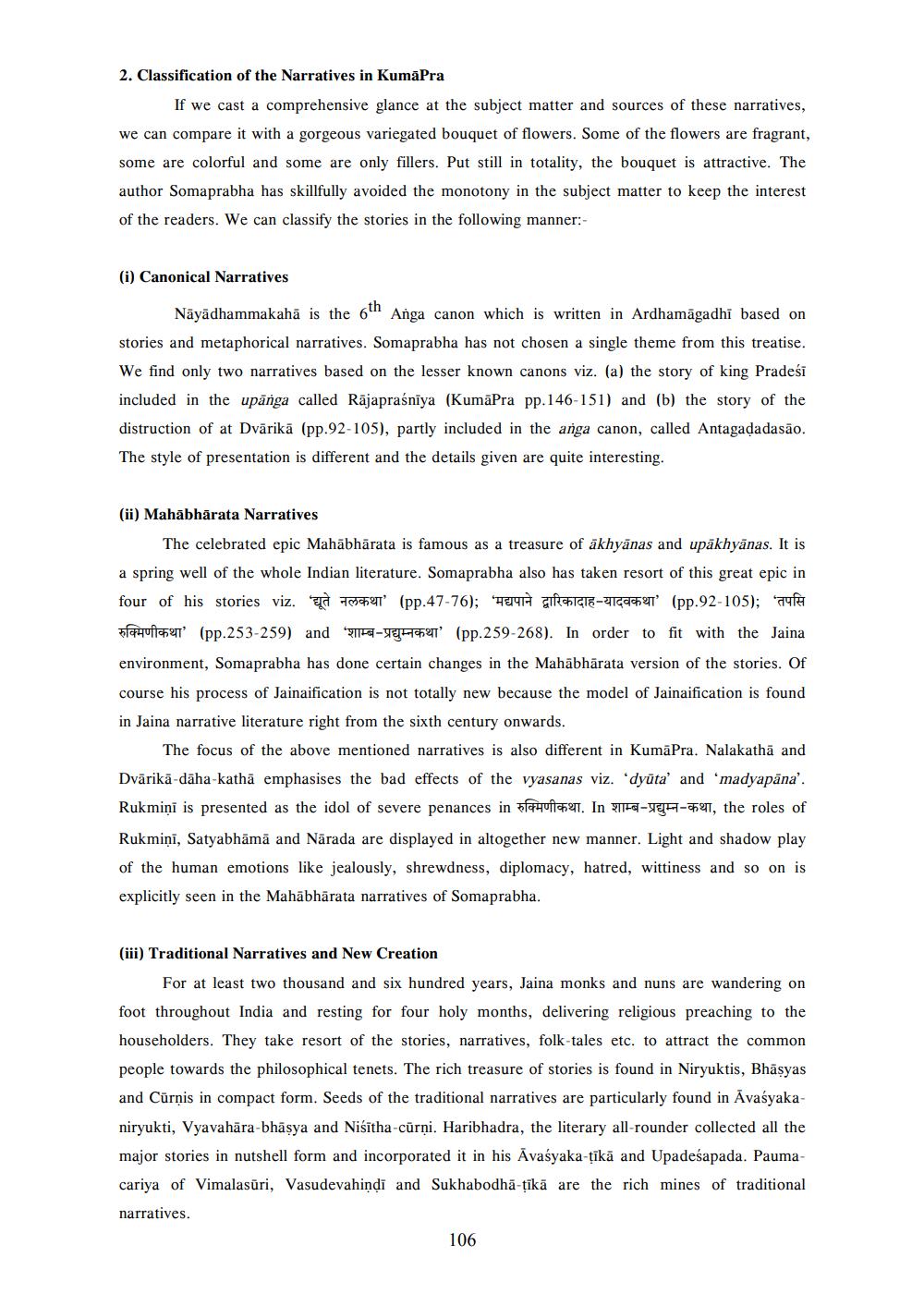________________
2. Classification of the Narratives in KumāPra
If we cast a comprehensive glance at the subject matter and sources of these narratives, we can compare it with a gorgeous variegated bouquet of flowers. Some of the flowers are fragrant, some are colorful and some are only fillers. Put still in totality, the bouquet is attractive. The author Somaprabha has skillfully avoided the monotony in the subject matter to keep the interest of the readers. We can classify the stories in the following manner:
(i) Canonical Narratives
Nāyādhammakahā is the 6 Anga canon which is written in Ardhamāgadhi based on stories and metaphorical narratives. Somaprabha has not chosen a single theme from this treatise. We find only two narratives based on the lesser known canons viz. (a) the story of king Pradesi included in the upānga called Rājapraśniya (KumāPra pp. 146-151) and (b) the story of the distruction of at Dvārikā (pp.92-105), partly included in the anga canon, called Antagadadasão. The style of presentation is different and the details given are quite interesting.
(ii) Mahābhārata Narratives
The celebrated epic Mahābhārata is famous as a treasure of ākhyānas and upākhyānas. It is a spring well of the whole Indian literature. Somaprabha also has taken resort of this great epic in four of his stories viz. Tocht' (pp.47-76); " a gifchTGE-416042 (pp.92-105); guft
fauften (pp.253-259) and a-Wh*2 (pp.259-268). In order to fit with the Jaina environment, Somaprabha has done certain changes in the Mahābhārata version of the stories. Of course his process of Jainaification is not totally new because the model of Jainaification is found in Jaina narrative literature right from the sixth century onwards.
The focus of the above mentioned narratives is also different in KumāPra. Nalakathā and Dvārikā dāha-kathā emphasises the bad effects of the vyasanas viz. dyūta' and 'madyapāna'. Rukmini is presented as the idol of severe penances in रुक्मिणीकथा. In शाम्ब-प्रद्युम्न-कथा, the roles of Rukmini, Satyabhāmā and Nārada are displayed in altogether new manner. Light and shadow play of the human emotions like jealously, shrewdness, diplomacy, hatred, wittiness and so on is explicitly seen in the Mahābhārata narratives of Somaprabha.
(iii) Traditional Narratives and New Creation
For at least two thousand and six hundred years, Jaina monks and nuns are wandering on foot throughout India and resting for four holy months, delivering religious preaching to the householders. They take resort of the stories, narratives, folk-tales etc. to attract the common people towards the philosophical tenets. The rich treasure of stories is found in Niryuktis, Bhāsyas and Cūrnis in compact form. Seeds of the traditional narratives are particularly found in Āvasyakaniryukti, Vyavahāra-bhāsya and Niśītha-cūrņi. Haribhadra, the literary all-rounder collected all the major stories in nutshell form and incorporated it in his Avaśyaka-tīkā and Upadesapada. Paumacariya of Vimalasūri, Vasudevahindi and Sukhabodhă-țīkā are the rich mines of traditional narratives.
106




